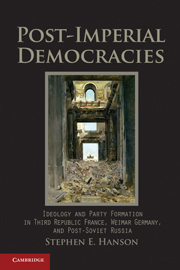 Post-Imperial Democracies
Post-Imperial Democracies Published online by Cambridge University Press: 05 June 2012
The evidence presented in this book suggests that the role of ideology as a causal variable in the early stages of party formation has been seriously underestimated by political scientists to date. Out of sixteen political parties examined, fifteen fit the central hypothesis advanced here: namely, that under conditions of intense institutional and social uncertainty, parties must have ideologies – that is, clear and consistent definitions of the principles governing membership in their preferred polity – to succeed in overcoming the collective action problems involved in creating national organizations of party activists, while nonideological parties fail to do so as a result of instrumentally rational free riding among party members. This hypothesis explains the otherwise puzzling success of the initially marginalized republicans and legitimists in France after the defeat at Sedan, and the concomitant organizational failure of the comparatively well-established Orléanists and Bonapartists. It explains the relative strength and endurance of the Social Democratic Party and monarchist German National People's Party in the 1920s, in comparison with the splintering of the German People's Party, the German Democratic Party, and the Independent Social Democrats; similarly, it explains the emergence of the Nazis and Communists in Weimar Germany – originally on the very fringes of political life – as the two major contenders for power in the late Weimar Period. Finally, our central hypothesis is borne out in post-Soviet Russia, where the relatively ideological Communist Party of the Russian Federation and Liberal Democratic Party of Russia managed to sustain their party organizations throughout the first sixteen years of the Russian Federation, while less ideologically consistent liberal parties and “parties of power” fractured – at least until the authoritarian regime of Vladimir Putin decided to build a pliable pro-Kremlin party from the top down (see Table 7.1).
To save this book to your Kindle, first ensure no-reply@cambridge.org is added to your Approved Personal Document E-mail List under your Personal Document Settings on the Manage Your Content and Devices page of your Amazon account. Then enter the ‘name’ part of your Kindle email address below. Find out more about saving to your Kindle.
Note you can select to save to either the @free.kindle.com or @kindle.com variations. ‘@free.kindle.com’ emails are free but can only be saved to your device when it is connected to wi-fi. ‘@kindle.com’ emails can be delivered even when you are not connected to wi-fi, but note that service fees apply.
Find out more about the Kindle Personal Document Service.
To save content items to your account, please confirm that you agree to abide by our usage policies. If this is the first time you use this feature, you will be asked to authorise Cambridge Core to connect with your account. Find out more about saving content to Dropbox.
To save content items to your account, please confirm that you agree to abide by our usage policies. If this is the first time you use this feature, you will be asked to authorise Cambridge Core to connect with your account. Find out more about saving content to Google Drive.